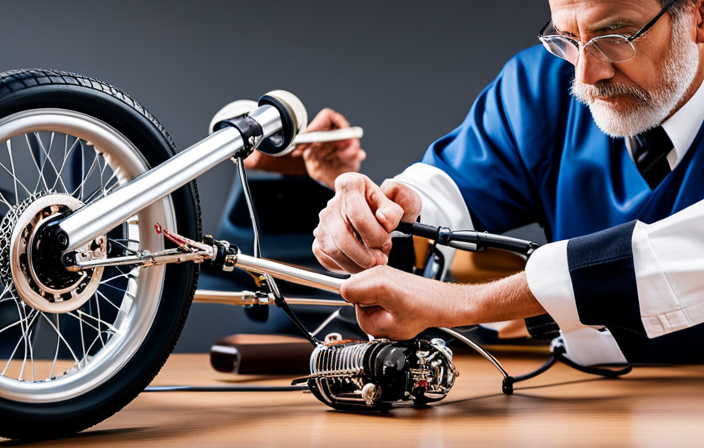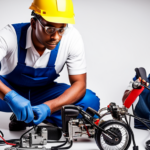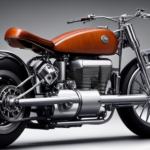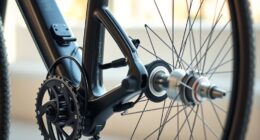So, you’ve got yourself an electric mini bike that’s fully charged, but it’s not running as smoothly as you’d like. Well, fear not, because I’ve got some expert tips to help you fix that baby up and get back on the road in no time.
From checking the power source to testing the battery voltage, we’ll cover all the necessary steps to troubleshoot and fix your electric mini bike.
So, let’s dive in and get your wheels spinning again!
Key Takeaways
- Inspect power supply unit, battery connections, and wiring for damage or corrosion
- Check battery voltage to ensure it is fully charged
- Examine fuses, motor connections, and casing for signs of damage or wear
- Regularly maintain and troubleshoot the electric mini bike to prevent issues and ensure optimal performance
Check the Power Source
First, make sure to check if the power source is working properly. When troubleshooting power issues on your electric mini bike, it’s crucial to identify any faulty components that may be causing the problem.
Start by inspecting the power supply unit and ensure that it is securely connected to both the bike and the outlet. Look for any signs of damage such as frayed wires or loose connections. If everything appears to be in order, check if the power switch is turned on and functioning correctly. Sometimes, a simple oversight can lead to a lack of power.
Next, examine the battery pack. Inspect the battery connections to ensure they are securely attached. Loose or corroded connections can disrupt the flow of power to the bike. If you notice any issues, carefully clean the terminals and reconnect them properly.
It is also important to verify if the battery pack is fully charged. Use a multimeter to measure the voltage and confirm if it falls within the recommended range.
Inspect the Battery Connections
Next, you’ll want to check the battery connections on your fully charged electric mini bike. It’s important to ensure that the connections are secure and free of any corrosion or damage. Here’s a step-by-step guide to inspecting the battery connections:
-
Visually examine the battery terminals: Take a close look at the positive (+) and negative (-) terminals on the battery. Make sure there is no rust, dirt, or any signs of corrosion. If you notice any buildup, gently clean it using a battery terminal cleaner or a mixture of baking soda and water.
-
Tighten the connections: Check if the battery terminals are tightly secured. Use a wrench or a pair of pliers to tighten them if necessary. Loose connections can lead to poor electrical contact and affect the performance of your electric mini bike.
-
Inspect the wiring: Trace the battery cables and inspect them for any signs of damage, such as frayed wires or exposed insulation. If you find any issues, it’s important to repair or replace the damaged wiring to ensure proper functioning.
With the battery connections properly inspected, it’s time to move on to the next step: testing the battery voltage.
Test the Battery Voltage
To test the battery voltage, you’ll need a multimeter and a set of jumper cables. Battery maintenance is crucial for the proper functioning of your electric mini bike.
One of the troubleshooting techniques involves checking the battery voltage. This process helps determine if the battery is providing the necessary power to keep your mini bike running smoothly.
Begin by connecting the positive (+) terminal of the battery to the positive (+) terminal of the multimeter using the jumper cables. Similarly, connect the negative (-) terminal of the battery to the negative (-) terminal of the multimeter. Set the multimeter to the DC voltage setting and ensure it is within the appropriate range for your battery.
Once everything is connected, switch on the multimeter and observe the reading. A fully charged battery should typically read around 12.6 volts. If the reading is significantly lower, it indicates a weak or discharged battery that may require charging or replacement.
Now, as we transition into the next section about examining the wiring and connections, we need to ensure that the battery voltage is within the acceptable range. If the battery voltage is normal, the issue may lie with the wiring or connections of your electric mini bike.
Examine the Wiring and Connections
Now that the battery voltage has been tested, it’s time to examine the wiring and connections of your electric mini bike. This step is crucial in troubleshooting any issues you may be experiencing.
Common issues with the wiring and connections can include loose or corroded connections, damaged wires, or faulty connectors.
To begin, visually inspect all the wiring and connections for any signs of damage or wear. Look for frayed wires, loose connections, or any signs of corrosion. If you spot any issues, they will need to be addressed and repaired.
Tighten any loose connections and clean any corroded areas with a wire brush or electrical cleaner. If you find any damaged wires, they will need to be replaced. Additionally, check all the connectors to ensure they are securely attached and not damaged.
By thoroughly examining the wiring and connections, you can identify and resolve any issues that may be affecting the performance of your electric mini bike.
Now, let’s move on to the next step, which is checking the fuse.
Check the Fuse
After visually inspecting the wiring and connections, it’s important to check the fuse for any signs of damage or blown connections. The fuse is a crucial component in the electrical system of your electric mini bike. It protects the circuit from overloading and prevents any potential damage to the motor or other electrical components.
To inspect the fuse box, locate it in the wiring system. It is usually a small box with a removable cover. Open the fuse box and carefully examine each fuse. Look for any signs of discoloration, melting, or a broken wire inside the fuse. These are clear indications of a blown fuse.
If you find a blown fuse, it needs to be replaced with a new one of the same rating. This can be done by simply pulling out the old fuse and inserting the new one. Be sure to use the correct amperage for your electric mini bike.
Checking the fuse is an essential step in troubleshooting power issues. It helps to identify any problems that may be causing the lack of power to the motor. Once you have inspected the fuse, the next step is to inspect the motor for any signs of damage or malfunction.
Inspect the Motor
Take a close look at the motor for any visible signs of damage or malfunction. This is an essential step in troubleshooting motor performance issues on your electric mini bike. Here are some key things to consider:
- Check for loose or disconnected wires. Ensure that all connections are secure and there are no loose or frayed wires that could be affecting the motor’s performance.
- Inspect the brushes and commutator. These components play a crucial role in the motor’s operation. Look for any signs of wear or damage, such as worn-out brushes or a damaged commutator.
- Examine the motor casing. Look for any cracks, dents, or other physical damage that could impact the motor’s efficiency. Even a small dent can affect its performance.
- Pay attention to unusual noises or vibrations. If you notice any unusual sounds or vibrations coming from the motor, it could be a sign of an underlying problem that needs to be addressed.
By thoroughly inspecting the motor and considering these troubleshooting tips, you can identify potential issues and take appropriate action to resolve them.
Now, let’s move on to testing the throttle and controller to further diagnose the problem without skipping a beat.
Test the Throttle and Controller
To test the throttle and controller, start by checking the connection between the throttle and the controller to ensure it is secure. A loose or faulty connection could lead to a malfunctioning throttle.
Once the connection is secure, you can proceed to test the throttle sensitivity. With the mini bike turned on and in a safe, open area, grip the throttle and gradually increase the pressure. Observe how the bike responds to your input. The throttle should provide a smooth and gradual increase in speed. If you notice any sudden surges or delays in acceleration, it may indicate a problem with the throttle sensitivity.
In such cases, it is recommended to troubleshoot the controller malfunction. This involves checking the wiring and connections between the controller and the throttle. Look for any loose or damaged parts that could be affecting the controller’s performance. Additionally, inspect the controller itself for any visible signs of damage.
It is important to address any issues with the throttle and controller before moving on to checking for loose or damaged parts, as these components play a crucial role in the bike’s overall functioning.
Check for Loose or Damaged Parts
Check if there are any loose or damaged parts that could be affecting the performance of the throttle and controller.
Electric mini bike maintenance is crucial to ensure optimal performance and longevity of your vehicle. When troubleshooting electric mini bikes, it is important to start by inspecting for any loose or damaged parts that could be causing issues.
Begin by visually examining the throttle and controller area. Look for any loose wires, connectors, or screws that may have come undone. Ensure all connections are secure and tight. Additionally, check for any sign of physical damage, such as cracks or breaks in the components. Such damage could be impacting the functionality of the throttle and controller.
If any loose or damaged parts are identified, tighten or replace them accordingly to restore proper operation.
Now that we have checked for loose or damaged parts, the next step is to clean and lubricate the moving parts of the electric mini bike.
Clean and Lubricate Moving Parts
Now that you’ve inspected for loose or damaged parts, it’s time to clean and lubricate the moving parts of your electric mini bike. Proper maintenance of these components is vital for ensuring smooth and efficient operation. Regular cleaning and lubrication techniques play a crucial role in extending the lifespan of your bike and preventing unnecessary wear and tear.
To effectively clean and lubricate the moving parts, refer to the table below for a step-by-step guide:
| Moving Part | Cleaning Technique | Lubrication Technique |
|---|---|---|
| Chain | Use a brush and degreaser to remove dirt and grime. | Apply a few drops of bicycle chain lubricant and wipe off excess. |
| Gears | Use a cloth or brush to remove debris and lubricant residue. | Apply a small amount of lubricant to each gear tooth. |
| Pedals | Wipe down with a damp cloth to remove dirt and dust. | Apply a light coating of lubricant to the pedal axles. |
| Bearings | Clean with a cloth and solvent to remove dirt and old lubricant. | Apply a high-quality bearing grease to ensure smooth rotation. |
Regular cleaning and lubrication not only keep your electric mini bike running smoothly but also help prevent rust and corrosion. It’s important to establish a routine maintenance schedule to ensure optimal performance and longevity of your bike.
Moving on to the next section, let’s take a look at how to adjust the brakes for optimal stopping power.
Adjust the Brakes
Once you’ve cleaned and lubricated the moving parts, it’s time to adjust the brakes on your electric mini bike. To ensure optimal brake performance, it is essential to adjust the brake pads correctly. Start by locating the brake pads on both sides of the wheel. Using an Allen wrench, loosen the bolts holding the brake pads in place. Position the pads so that they are aligned with the rim of the wheel and tighten the bolts securely.
Next, it’s crucial to test the brake responsiveness. Mount your electric mini bike and roll it forward at a slow speed. Squeeze the brake lever gently to engage the brakes. The brake pads should make contact with the rim of the wheel smoothly and without any delay. If the brakes feel too loose or tight, adjust the tension by loosening or tightening the cable attached to the brake lever until the desired responsiveness is achieved.
Now that the brakes are adjusted, it’s time to inspect the tires and wheels. Transitioning from brake adjustment, it is essential to ensure your electric mini bike’s tires are in good condition and properly inflated.
Inspect the Tires and Wheels
To ensure optimal performance, make sure the tires on your electric mini bike are properly inflated and in good condition. Checking tire pressure and inspecting wheel alignment are crucial steps in maintaining your bike’s safety and efficiency. Here is a table summarizing the recommended tire pressure and wheel alignment specifications:
| Tire Pressure (psi) | Front Wheel Alignment | Rear Wheel Alignment |
|---|---|---|
| 30-35 | 0°-2° toe-in | 0°-2° toe-in |
To check the tire pressure, use a tire gauge and compare the reading with the recommended range. Inflate or deflate the tires as needed to match the specified pressure. It is important to inspect the wheel alignment to prevent uneven tire wear and ensure stable handling. Measure the toe-in using a measuring tape or alignment tool. Adjust the alignment by loosening the axle nuts and aligning the wheels according to the specifications. Once the tire pressure and wheel alignment are in check, your electric mini bike will provide a smooth and safe ride.
Now that we have inspected the tires and wheels, let’s move on to the next section where we test the lights and signals without skipping a beat.
Test the Lights and Signals
Make sure you check the lights and signals on your electric mini bike to ensure they are functioning properly. Troubleshooting tips and common issues related to lights and signals can help you identify and fix any problems you may encounter.
First, start by checking the headlights. Make sure they are properly aligned and not flickering. If the headlights don’t turn on, check the wiring connections to ensure they are secure. Sometimes, loose connections can cause the lights to malfunction.
Next, test the brake lights. Apply the brakes and see if the lights illuminate. If they don’t, check the brake light switch and wiring for any faults. It’s also important to check the turn signals. Make sure they are working on both the front and rear of the bike. If the turn signals are not flashing or not working at all, check the bulbs, wiring, and flasher relay for any issues.
Consult the User Manual or Online Resources
If you’re unsure about how to troubleshoot any issues with your electric mini bike’s lights and signals, consulting the user manual or searching online resources can provide you with helpful guidance.
When it comes to troubleshooting techniques for common issues with the lights and signals on your electric mini bike, here are a few things to keep in mind:
-
Check the connections: Ensure that all the wiring connections are secure and not loose. Loose connections can cause flickering lights or signal malfunctions.
-
Inspect the bulbs: Check the bulbs to see if they are burnt out or damaged. Replace any faulty bulbs with new ones to restore proper functionality.
-
Test the switches: Use a multimeter to check if the switches are working correctly. Faulty switches can prevent the lights and signals from turning on or off.
-
Examine the fuses: Inspect the fuses to see if any of them are blown. Replace any blown fuses with new ones of the same rating.
Remember to seek professional assistance if needed. A certified technician can diagnose and fix any complex electrical issues that may require specialized knowledge and tools.
Seek Professional Assistance if Needed
After exhausting all the available resources and troubleshooting tips, I realize that my electric mini bike is still not functioning properly. It’s frustrating, but it’s important to remember that sometimes we need to seek professional assistance to resolve complex issues. In cases where the problem persists despite our best efforts, it is wise to consult a professional who has the knowledge and experience to diagnose and fix the problem accurately.
When seeking professional help, it is essential to find a technician or a repair shop that specializes in electric mini bikes or similar vehicles. They will have the necessary tools and expertise to identify the root cause of the issue and provide an appropriate solution. It is advisable to check for customer reviews and recommendations to ensure that you choose a reliable and reputable service provider.
While professional assistance can be costly, it is often the most efficient way to get your electric mini bike back on track. Their expertise can save you time and prevent further damage caused by improper repairs. However, if you decide to tackle the repairs yourself, make sure to practice regular maintenance and care to prevent future issues.
Transition: Now that we have explored seeking professional help, let’s dive into the importance of practicing regular maintenance and care for your electric mini bike.
Practice Regular Maintenance and Care
To ensure optimal performance and longevity of your electric mini bike, it’s crucial that you regularly maintain and care for it. Here are three important steps to follow:
-
Keep the Battery Charged: Regularly charge your electric mini bike’s battery to ensure that it remains at peak performance. This will not only extend the battery’s lifespan but also prevent any unexpected power failures during your rides.
-
Clean and Lubricate the Chain: The chain is a critical component of your electric mini bike, as it transfers power from the motor to the wheels. Regularly clean and lubricate the chain to prevent dirt and debris from accumulating, which can lead to increased friction and wear. This simple step will help maintain the efficiency and smooth operation of your bike.
-
Check Tire Pressure: Proper tire pressure is essential for a safe and comfortable ride. Regularly check the tire pressure and make sure it is within the recommended range. Underinflated tires can affect the handling and performance of your electric mini bike, while overinflated tires can lead to reduced traction and increased risk of punctures.
Frequently Asked Questions
How do I charge my electric mini bike?
To charge my electric mini bike, I first need to locate the charging port on the bike. Typically, it is located near the battery or on the frame.
I then plug the charger into a standard electrical outlet and connect it to the charging port. It’s important to ensure a secure connection.
Once connected, I can leave the bike to charge for the recommended amount of time to fully recharge the battery.
Regular charging and proper maintenance can help prevent common issues and ensure optimal performance.
What should I do if the battery connections are loose?
If the battery connections on your electric mini bike are loose, it’s important to address the issue promptly to ensure proper functionality.
To fix loose battery connections, you’ll need to start by disconnecting the battery. Then, carefully tighten the connection points using a wrench or pliers. Ensure that the connections are secure, but be cautious not to overtighten and damage the terminals.
Once the connections are tightened, reconnect the battery and test the bike for any remaining electrical issues. Troubleshooting common electrical issues on electric mini bikes may involve checking the wiring, fuse, or controller, so it’s important to consult the bike’s manual or seek professional assistance if needed.
How can I test the voltage of the battery?
To test the voltage of the battery, I recommend using a testing equipment called a voltmeter. This device allows you to measure the electrical potential difference between two points.
To begin, set the voltmeter to the DC voltage range and connect the positive lead to the positive terminal of the battery and the negative lead to the negative terminal.
The voltmeter will display the voltage reading, which can help in troubleshooting techniques for your electric mini bike.
What should I do if there is a problem with the wiring or connections?
If there’s a problem with the wiring or connections, troubleshooting becomes crucial. It’s like untangling a web of confusion.
Start by inspecting each connection and wire, ensuring they are secure and free from damage. Look out for loose connections or frayed wires, as these are common electrical issues.
Use a multimeter to test the continuity and resistance of the wires. By diligently identifying and addressing wiring problems, you’ll be on track to resolving any issues with your electric mini bike.
How do I adjust the brakes on my electric mini bike?
To adjust the brakes on an electric mini bike, start by examining the brake pads. Ensure they’re properly aligned and make contact with the wheel rim evenly. If the pads are worn out, replace them.
Next, inspect the brake cables for any signs of damage or looseness. If necessary, tighten or replace the cables.
Conclusion
In conclusion, by following these steps, I was able to troubleshoot and fix my fully charged electric mini bike.
- Checking the power source
- Inspecting battery connections
- Testing the battery voltage
- Examining the wiring and connections
- Checking the fuse
- Testing the lights and signals
All of these steps are crucial in diagnosing and resolving any issues. Additionally, consulting the user manual or online resources and seeking professional assistance when needed are key to ensuring the proper functioning of the bike.
Lastly, practicing regular maintenance and care will help prevent future problems. Remember, maintaining your electric mini bike is essential for a smooth and enjoyable ride.















